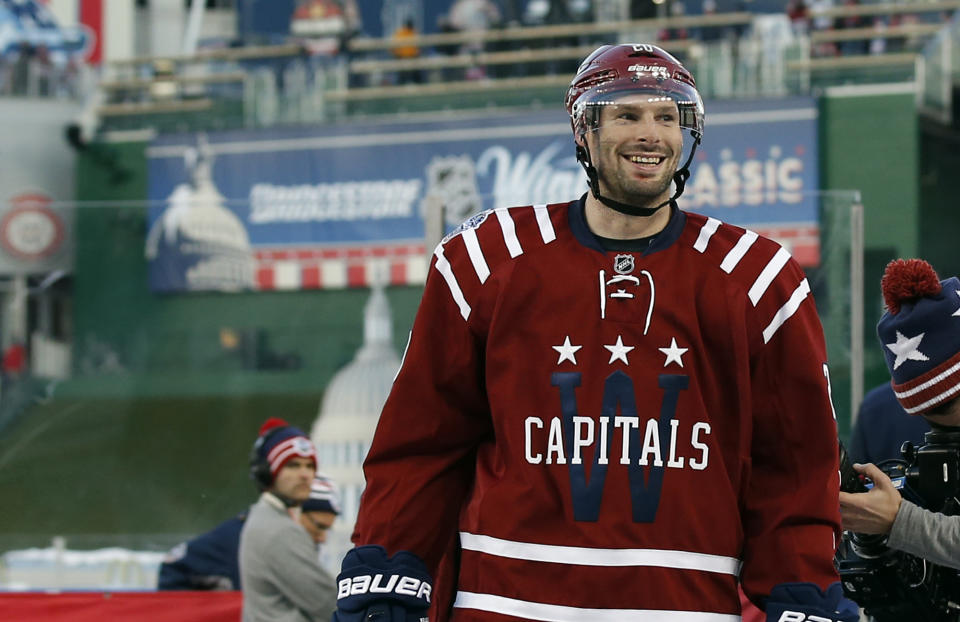NHL Winter Classic earns lowest rating in game’s history

The overnight ratings story for the 2015 Winter Classic isn’t a pretty one for the National Hockey League, but it’s not like they didn’t see it coming.
NBC is reporting a 2.3 overnight rating for the game between the Chicago Blackhawks and the Washington Capitals from Nationals Park in D.C., which is the lowest overnight number among the seven Winter Classics.
The previous low was the 2.4 overnight that the Philadelphia Flyers and New York Rangers earned at Citizens Bank Park in Philly. Keep in mind that game was on Jan. 2, a Monday afternoon, with a shift in starting time.
Via Richard Deitsch of Sports Illustrated, a brief primer on previous overnights:
2015: 2.3 (Blackhawks/Capitals)
2014: 2.9 (Leafs/Red Wings)
2013: No game.
2012: 2.4 (Rangers/Flyers)
2011: 2.8 (Capitals/Penguins)
2010: 2.6 (Flyers/Bruins)
2009: 2.9 (Red Wings/Blackhawks)
2008: 2.6 (Penguins/Sabres)
Here’s how NBC spun the ratings news:
Yesterday’s NHL Winter Classic between @NHLBlackhawks & @washcaps posts 2.3 overnight rating, up 77% vs 2013-14 reg season avg on NBC (1.3)
— NBC Sports PR (@NBCSportsPR) January 2, 2015
Hey, good news everybody: a hockey game played outside in a baseball stadium drew significantly higher ratings than a regular season game last year! Huzzah! Champagne corks!
Chicago posted 11.4 HH rating & Washington scored a 5.7 HH rating. NBC was No. 1 network in both markets during NHL Winter Classic
— NBC Sports PR (@NBCSportsPR) January 2, 2015
Super impressive that it managed to out-rate the Missouri/Minnesota Citrus Bowl in both markets.
Top 5 NHL Winter Classic markets: 1-Chicago, 11.4 HH rating; 2-Buffalo, 6.4; 3-Washington, DC, 5.7; 4-St. Louis, 3.9; 5-Pittsburgh, 3.5
— NBC Sports PR (@NBCSportsPR) January 2, 2015
The Blackhawks' last trip to the Winter Classic in 2009? Preliminary local ratings were 11.8 in Chicago and 10.5 in Detroit, according to Nielsen data.
Buffalo, incidentally, was also the second-best market last season with the Leafs playing at the Big House. Pittsburgh (7.0) was third, St. Louis (4.4) was fourth. D.C. was 10th with a 3.6 rating.
The D.C. market didn’t pop the number the NHL needs from another dance partner in this game. Without a city like Detroit or Boston (next year’s host, likely) in the game to deliver a ridiculous local figure on its own, the NHL needs both teams to contribute to the audience and the D.C. market couldn’t get there. (Wonder if some of those 40,000-plus Capitals fans at the game are Nielsen families.)
But as we said the last time the ratings dipped: Venue and aesthetics matter.
Wrigley, Fenway and the Big House were draws on their own. Two cookie-cutter ballparks aren’t.
Wrigley had wind. Buffalo and Ann Arbor had frozen temps and swirling snow. The Pittsburgh game was played at night. The Washington game was a downright balmy 43 degrees with blue skies. The draw of any outdoor game remains “teams vs. elements” and sun glare isn’t exactly that compelling.
Matchups matter, too, and this one featured a third-timer in the Blackhawks for outdoor games (including last season at Solider Field) against a team against whom they have absolutely no rivalry. It was an entertaining game, sure, but one that lacked the heat that other matchups had. And the geographic distance between the cities meant the most partisan crowd in the game’s history – didn’t you miss the red vs. blue from the Big House in the stands?
But again, here’s the thing: If there’s Winter Classic fatigue amongst television viewers, it’s not found at the venues or in the host cities.
It’s basically the Super Bowl there, or at the very least a very chilly Comic-Con. It's an event, like the NHL All-Star Game, that exists for the local fans and NHL sponsors and the glorious generation of cash.
The NHL isn’t going to care about the ratings (well, unless they slip under a 2.0) if the revenues on-site remain insanely good. From Yahoo Sports’ Nick Cotsonika:
The average ticket price is $205, so the gate alone will be almost $9 million. (A normal gate would be about $1 million, maybe $1.5 million.) Now add about $5 million in sponsorships and about $2 million in concessions. Now add millions more in merchandise.
Now subtract millions in costs – stadium rental, entertainment, staging. Is this a cash grab? Yeah, you bet it’s a cash grab, in the sense that the purpose of professional sports is to make money. But the NHL also invests a lot of money into the product to add value to the tickets – it’s an event, not just a game – and make the business model sustainable. The league makes a profit of about 30 to 40 percent.
So the gate is roughly nine times that of a regular season game, and the merch they sold on-site might even eclipse that. The eye test at Nats Park tells you that roughly 40 percent of the Capitals fans in attendance were wearing the new Winter Classic jerseys. It was insane.
Unless the ratings bottom out – and they’ll probably bounce back next year as all of New England tunes in to see Milan Lucic chase P.K. Subban around Foxboro Stadium – the NHL will be rather content to continue with the Winter Classic’s course of using roughly a half dozen teams and cities, and then using the Stadium Series and Heritage Classic to open up ATM machines for their coffers in other markets.
(An aside: Would the Kings and Sharks have produced a better number on New Year's Day?)
It's not the automatic draw it was thanks to the saturation of outdoor games and a little fatigue from seeing the same franchises time and again in them. But that doesn't mean, ratings be damned, that it's not a success for the League, from a profile-building perspective and a monetary.
The bloom’s off the rose, but the gild’s not off the lily.



